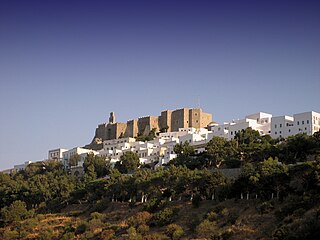
Patmos is a Greek island in the Aegean Sea. It is famous as the location where John of Patmos received the visions found in the Book of Revelation of the New Testament, and where the book was written.

The Monastery of Saint John the Theologian is a Greek Orthodox monastery founded in 1088 in Chora on the island of Patmos. It is named after St. John of Patmos, the author of the Christian Book of Revelation who, according to the text, lived on the island when visions of the apocalypse came to him. Since its founding, the monastery has been a pilgrimage site and a place of Greek Orthodox learning and worship. The monastery is unique in that it integrated from its founding the surrounding community of Chora, which was built around its fortifications. Religious ceremonies that date back to the early Christian period are still practiced within the monastery today. Because of its sacred significance, uninterrupted architectural evolution, and the exceptional preservation of early Christian customs, the monastery was declared a UNESCO World Heritage Site in 1999, along with the town of Chora and the nearby Cave of the Apocalypse.

The Cave of the Apocalypse is located approximately halfway up the mountain on the Aegean island of Patmos, along the road between the villages of Chóra and Skala. This grotto marks the spot where St. John of Patmos received his visions that he recorded in the Book of Revelation. It became a location of Christian pilgrimage and is recognized as a Greek Orthodox Church to this day. In 1999, UNESCO declared the cave a joint World Heritage Site, as one of the most sacred sites of Christianity.

Apocalypse or The Apocalypse is a biblical telefilm produced for European television released in 2002 starring Richard Harris and co-starring Bruce Payne.

Ilias or Elias Moskos was a Greek educator, shipping merchant and painter from Crete. The last name Moskos was associated with three famous painters of the Cretan School alive during the same period, along with Ioannis Moskos and Leos Moskos, possibly his relatives. Elias incorporated maniera greca with the Venetian style. Theodore Poulakis and Moskos brought the art and style of Crete into the Heptanese School of the Ionian Islands. Some of his work was inspired by Angelos Akotantos. He was affiliated with other artists such as Philotheos Skoufos. He is often confused with Leos Moskos. His son was not Ioannis Moskos although they were probably related. Elias most popular painting is Christ Pantocrator. Fifty-two of his paintings survived.

Ιoannis Apakas, also known as Johann Apakass was a Greek painter and priest. He was active in the latter part of the 16th century to the early 17th century. He was popular artist during his time.
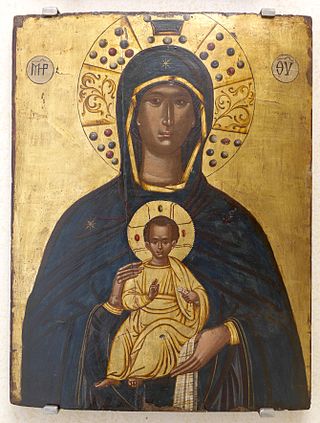
Thomas Bathas was a Greek painter, educator, and Vikar. He employed the maniera greca in some of his work but he also broke from tradition by employing the Venetian style. He traveled around the Venetian Empire going from Heraklion to Corfu and Venice. He was a prominent member of the Greek Confraternity in Venice. He was friends with Gabriel Severus, Metropolitan of Philadelphia. He was very popular among both Greek and Italian patrons. He influenced the works of countless artists both Italian and Greek. Some of his works are in San Giorgio dei Greci and the Hellenic Institute of Venice. Emmanuel Tzanes, Konstantinos Tzanes, Ioannis Moskos, and Philotheos Skoufos were some Greek artists influenced by his work. One of his students was the famous painter Emmanuel Tzanfournaris. He left him a fortune in his will. His most famous works include: Portrait of Gabriel Severus and Virgin and Child Enthroned. Twenty of his paintings have survived.

The Virgin Nikopoios also known as Panagia Nikopoios is a tempera painting by Thomas Bathas. Bathas was active in Heraklion, Venice, and Corfu during the second half of the 16th century. The painting follows the traditional Byzantine style characteristic of the traditional maniera greca. The painting also featured the Venetian style. The position of the Virgin and Child is the Nikopoios. The word Nicopeia is indicative of Constantinople. There are actually many different types.

The Last Judgment also known as The Second Coming is an egg tempera painting by Francheskos Kavertzas. His artistic period was during the first part of the 17th century. Seven of his works survived, five were signed. He was a member of the late Cretan School. The Last Judgment painted by Georgios Klontzas inspired countless Cretan artists, Kavertzas was one of them. Kavertzas's painting In You Rejoiceth strongly resembles Klontzas's In Thee Rejoiceth. Leos Moskos was also inspired by Klontzas's work. He also painted a similar version of The Last Judgment. The final judgment is the last judgment of every person on earth. The painting is a pictural representation of that event. The Kavertzas The Last Judgment is unique because it features a nun. Her name was Evgenia Trapezontiopoulla. According to records on March 9, 1641, the nun could not afford to pay for the painting. Kavertzas and the nun bartered instead. The painting is part of the collection of the Hellenic Institute of Venice in Italy.
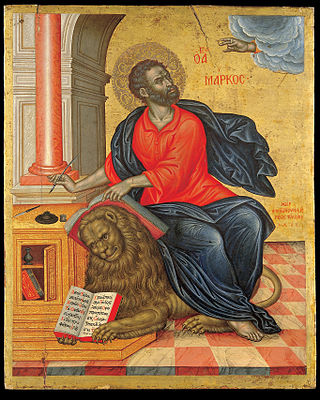
Saint Mark is a tempera-on-wood painting created c. 1657 by Emmanuel Tzanes. Tzanes was a Cretan painter who migrated to Corfu and Venice. He settled in Venice with his brothers Konstantinos Tzanes and poet Marinos Tzanes. Konstantinos was a famous painter. Their combined existing works number over 150. Emmanuel replaced Greek painter Philotheos Skoufos as the priest of San Giorgio De Greco.
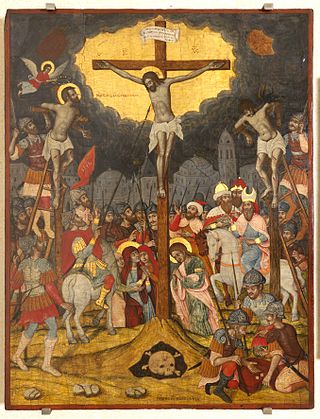
The Crucifixion is an egg tempera painting created by Ioannis Moskos. Moskos was a Greek painter originally from Crete. He migrated to Venice. Two other painters named Moskos were active during the same period. Their names were Elias Moskos and Leos Moskos. Leos and Ioannis were both in Venice during the same period. Ioannis was a member of the Late Cretan School. He was active from 1650 to 1721. Forty-four of his paintings survived.
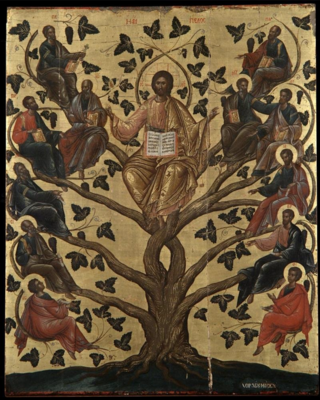
Christ the Vine, also known as the Tree of Christ, is a tempera painting by Leos Moskos. Moskos was active from 1620 to 1690. Twenty of his works have survived. He was originally from Rethimno, Crete. He traveled all over the Venetian empire. He worked on the Ionian islands of Cephalonia and Zakynthos. He also worked in Venice. Two other painters with the same last name were active during the same period. They were Elias Moskos and Ioannis Moskos. All three artists painted in the same style. Leos was in Venice around the same period as Ioannis. There is strong evidence that the three were related. Famous Greek painter and historian Panagiotis Doxaras was Leo’s student.

The Stoning of Stephen is a tempera and gold leaf painting by Philotheos Skoufos. Skoufos was active on the island of Crete. He traveled to Venice and eventually settled on the island Zakynthos. He was briefly a priest at the famous Greek church in Venice San Giorgio dei Greci. Nineteen of his works have survived. Skoufos created notable copies of Damaskinos's paintings namely The Stoning of Stephen and The Beheading of John the Baptist.

Christ the Vine is an egg tempera painting by Victor. Victor was a Cretan painter active during the 17th century. The painter traveled all over the Venetian empire. He eventually settled in Zakinthos. He is one of the most important painters of the 17th century due to the enormous amount of his existing works. His catalog of art exceeds over ninety-five paintings.

Christ Enthroned is a tempera icon by Emmanuel Tzanes, a Greek painter of the Late Cretan School. It is currently at the Byzantine & Christian Museum in Athens.
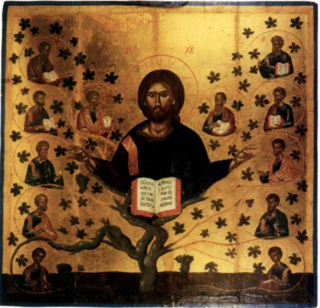
Christ the Vine is a tempera painting created by Greek painter Angelos. Angelos was active from 1425 to 1457. He was a teacher and protopsaltis. His students included some of the most famous painters of the early Cretan Renaissance. Andreas Pavias and Andreas Ritzos were his students and were heavily influenced by his style. Forty-nine of his works survived. Angelo’s Christ the Vine was one of his most important works.
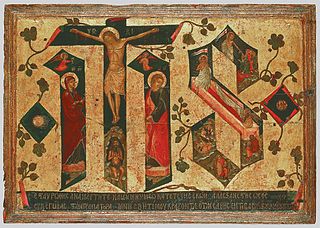
Jesus Hominum Salvator is a tempera painting by Andreas Ritzos. Ritzos was one of the founders of the Cretan School of painting. His teacher was Angelos Akotantos. Andreas Ritzos was active from 1436 to 1492. He painted in the traditional Greek-Italian Byzantine style combined with Italian Renaissance Venetian painting. The technique later became known as the maniera greca. Sixty of his works survived.
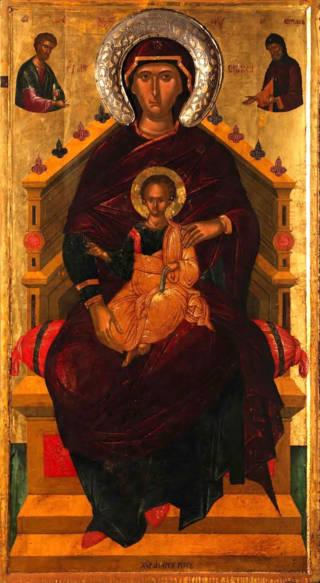
The Virgin Pantanassa is a tempera painting by Andreas Ritzos. Ritzos was a Greek painter active on the island of Crete. He flourished from 1435 to 1492. The painter has an existing catalog of over sixty works attributed to him. He signed his works in both Greek and Latin. He is one of the most influential painters of the Cretan Renaissance. He painted in the traditional Greek-Italian Byzantine style. His work was also heavily influenced by Venetian painting. His teacher was Angelos Akotantos. He was also affiliated with Andreas Pavias. His son was famous Greek painter Nikolaos Ritzos. Ritzo's Italian contemporaries were Paolo Uccello and Fra Angelico. They all painted a mixture of the Greek-Italian Byzantine and Italian Renaissance styles. The art of Crete was heavily influenced by the founder of the Venetian school Paolo Veneziano.

The Holy Trinity is a tempera painting created by Spyridon Romas. He was a Greek painter from Corfu. He was a prominent member of the Heptanese School. He was active from 1745 to 1786. He traveled all over the world. He painted in Corfu, Lecce, Livorno, and London. According to the Hellenic Institute over 25 of his works survived. He is one of the few Greek painters to completely adopt a new style of painting. He traveled to London, England around 1770 and remained in the country until his death. He painted several portraits but also maintained artwork in the region. An iconostasis with most of his works is superlatively preserved in Livorno, Italy at the Museo della Città di Livorno.

The Incredulity of Saint Thomas is a tempera painting created by Greek painter Emmanuel Tzanes. Tzanes features a catalog of artwork numbering over one hundred works. He was one of the most prolific artists of the 1600s painting in Crete, Corfu, and Venice. His two brothers Marinos Tzanes and Konstantinos Tzanes were also famous painters but Marinos is more well known for his famous poem The Cretan War Ο Κρητικός Πόλεμος. All three artists were members of the Late Cretan School and early Heptanese School (painting) they were known for participating in the movement that integrated Flemish engravings into the Greek and Italian art world.


















